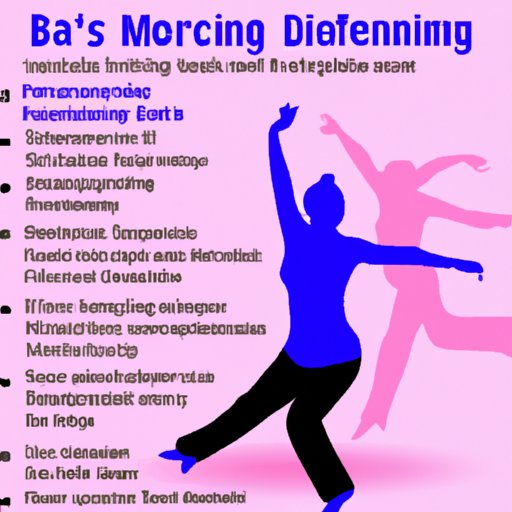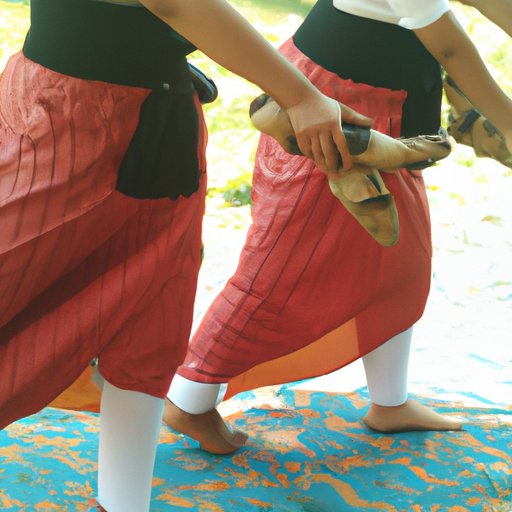Introduction
Dance is a form of physical expression that has been used by humans for centuries. It is a creative outlet that allows us to connect with our emotions, express ourselves, and communicate with others. At its core, dancing is about movement and rhythm, and it can take many forms, from traditional folk dances to modern hip hop.
The history of human dance is complex and varied. From ancient tribal rituals to modern nightclubs, dance has always been an important part of human culture and society. In this article, we explore why humans dance, looking at its physical and mental benefits, the evolution of dance styles, examples of traditional cultural dances, and the power of dance to bring people together.

Physical and Mental Benefits of Dancing
Dancing has numerous physical and mental benefits. Studies have shown that regular dancing can improve physical health, increase cognitive ability, and have positive effects on mental health.
In terms of physical health, dancing can help to strengthen the muscles, increase flexibility and range of motion, and improve coordination and balance. According to a study published in the British Journal of Sports Medicine, “dancing has been associated with improved cardiorespiratory endurance, muscular strength and endurance, flexibility, body composition, neuromuscular control, and motor performance.”
In terms of cognitive ability, dancing can help to sharpen the mind. A study conducted by the Albert Einstein College of Medicine found that “dancing regularly may be beneficial in preserving or enhancing cognitive skills, such as memory, reasoning, and processing speed.”
Finally, in terms of mental health, dance can be a powerful tool for reducing stress and anxiety. The American Dance Therapy Association states that “dance/movement therapy can provide physical and emotional relief for individuals struggling with depression, trauma, and other mental health issues.”
Evolution of Dance Styles
Over the centuries, human dance has evolved from traditional cultural dances to popular contemporary styles. Historically, dance was closely linked to music, with different styles of music inspiring different styles of dance.
Traditional cultural dances are rooted in a particular culture or region. These dances often have symbolic meanings and are used to celebrate special occasions or to mark religious ceremonies. Examples of traditional cultural dances include African tribal dances, Asian folk dances, and Latin American social dances.
As technology has advanced, so too has the nature of dance. Music has become more sophisticated, allowing for the development of new dance styles and genres. Popular contemporary dance styles include hip hop, breakdancing, jazz, and salsa.

Examples of Traditional Cultural Dances
Traditional cultural dances are an important part of many cultures around the world. Here are some examples:
African tribal dances: African tribal dances are a form of social and spiritual expression. These dances are often used to celebrate special occasions and to honor ancestors. Examples of African tribal dances include the Gumboot dance from South Africa and the Dahomey dance from West Africa.
Asian folk dances: Asian folk dances are often performed at festivals and celebrations. Examples of Asian folk dances include the Dragon dance from China, the Bhangra dance from India, and the Bon Odori dance from Japan.
Latin American social dances: Latin American social dances are typically performed in a group setting. Examples of Latin American social dances include the Salsa from Cuba, the Samba from Brazil, and the Cumbia from Colombia.
Power of Dance to Bring People Together
In addition to its physical and mental benefits, dance can also be a powerful tool for bringing people together. By creating a sense of unity, dance can help to bridge cultural differences and foster understanding and empathy.
Throughout history, dance has played an important role in creating a sense of community and solidarity. For example, during the civil rights movement in America, many people used dance as a way to express their feelings and unite in a common cause. Similarly, in recent years, the Black Lives Matter movement has seen people using dance to show their support for the cause.
Dance can also be used to bring people together across cultures and borders. Around the world, there are countless examples of people coming together through dance, from flash mobs to street performances. Through dance, people can share their stories and experiences and create a sense of connection and understanding.
Conclusion
Humans have been dancing for centuries, and it has played an important role in human history. From its physical and mental benefits to its potential to bring people together, dance remains an integral part of human culture. Whether it’s a traditional cultural dance or a modern style, dance is a powerful form of expression and communication that should be celebrated and embraced.
(Note: Is this article not meeting your expectations? Do you have knowledge or insights to share? Unlock new opportunities and expand your reach by joining our authors team. Click Registration to join us and share your expertise with our readers.)
